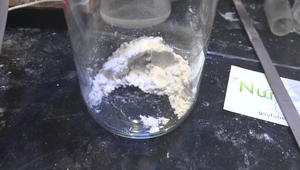Guanidinium chloride
From Sciencemadness Wiki
 Guanidine hydrochloride made from no-lye hair relaxants
| |
| Names | |
|---|---|
| IUPAC names
Guanidinium chloride
Carbamimidoylazanium chloride | |
| Other names
Aminoformamidine hydrochloride
Aminomethanamidine hydrochloride Guanidine chloride Guanidine hydrochloride | |
| Properties | |
| CH6N3Cl | |
| Molar mass | 95.53 g/mol |
| Appearance | White solid |
| Odor | Odorless |
| Density | 1.354 g/cm3 (20 °C) |
| Melting point | 182.3 °C (360.1 °F; 455.4 K) |
| Boiling point | Decomposes |
| 57.318 g/100 ml (20 °C) | |
| Solubility | Soluble in ethanol, methanol Insoluble in hydrocarbons |
| Vapor pressure | ~0 mmHg |
| Hazards | |
| Safety data sheet | Sigma-Aldrich |
| Related compounds | |
| Related compounds
|
Guanidinium carbonate Guanidinium nitrate Guanidinium perchlorate Guanidinium sulfate |
| Except where otherwise noted, data are given for materials in their standard state (at 25 °C [77 °F], 100 kPa). | |
| Infobox references | |
Guanidinium chloride or guanidine hydrochloride, usually abbreviated GuHCl, GdnHCl or GdmCl is an organic chemical compound, source of guanidinium ions.
Contents
[hide]Properties
Chemical
Guanidinium chloride will decompose at very high temperatures to release hydrochloric acid fumes.
Physical
Guanidinium chloride is a white solid, very soluble in water.
Availability
Guanidinium chloride is sold by many chemical suppliers. Can also be bought online.
Preparation
Can be prepared by adding hydrochloric acid to guanidine freebase or guanidinium carbonate.
Projects
- Make guanidinium compounds
- Protein denaturant
Handling
Safety
Guanidinium compounds are relative safe to handle.
Storage
Guanidinium chloride is best kept in closed bottles.
Disposal
No special disposal is required, though chlorides in large amounts tend to be harmful to the soil.